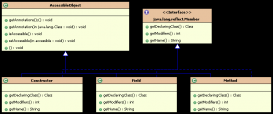本文实例讲述了java实现求两个字符串最大公共子串的方法。分享给大家供大家参考,具体如下:
最近在项目工作中有一个关于文本对比的需求,经过这段时间的学习,总结了这篇博客内容:求两个字符串的最大公共子串。
算法思想:基于图计算两字符串的公共子串。具体算法思想参照下图:

输入字符串S1:achmacmh 输入字符串S2:macham
- 第a步,是将字符串s1,s2分别按字节拆分,构成一个二维数组;
- 二维数组中的值如b所示,比如第一行第一列的值表示字符串s2和s1的第一个字节是否相等,若相等就是1,否则就是0,最终产生b所示的二维数组;
- 分别求二维数组中斜线上的公共因子(斜线为元素a右下角值,即a[i][j]的下一个元素是a[i+1][j+1];公共因子为1所在的位置构成的字符串);
- 对所有公共因子排序,返回最大的公共因子的值。
具体的实现代码如下所示:
|
1
2
3
4
5
6
7
8
9
10
11
12
13
14
15
16
17
18
19
20
21
22
23
24
25
26
27
28
29
30
31
32
33
34
35
36
37
38
39
40
41
42
43
44
45
46
47
48
49
50
51
52
53
54
55
56
57
58
59
60
61
62
63
64
65
66
67
68
69
70
71
72
73
74
75
76
77
78
79
80
81
82
83
84
85
86
87
88
89
90
91
92
93
94
95
96
97
98
99
100
101
102
103
104
105
|
package cn.lulei.compare; import java.util.ArrayList; import java.util.Collections; import java.util.Comparator; import java.util.List; public class StringCompare { private int a; private int b; public String getMaxLengthCommonString(String s1, String s2) { if (s1 == null || s2 == null) { return null; } a = s1.length();//s1长度做行 b = s2.length();//s2长度做列 if(a== 0 || b == 0) { return ""; } //设置匹配矩阵 boolean [][] array = new boolean[a][b]; for (int i = 0; i < a; i++) { char c1 = s1.charAt(i); for (int j = 0; j < b; j++) { char c2 = s2.charAt(j); if (c1 == c2) { array[i][j] = true; } else { array[i][j] = false; } } } //求所有公因子字符串,保存信息为相对第二个字符串的起始位置和长度 List<ChildString> childStrings = new ArrayList<ChildString>(); for (int i = 0; i < a; i++) { getMaxSort(i, 0, array, childStrings); } for (int i = 1; i < b; i++) { getMaxSort(0, i, array, childStrings); } //排序 sort(childStrings); if (childStrings.size() < 1) { return ""; } //返回最大公因子字符串 int max = childStrings.get(0).maxLength; StringBuffer sb = new StringBuffer(); for (ChildString s: childStrings) { if (max != s.maxLength) { break; } sb.append(s2.substring(s.maxStart, s.maxStart + s.maxLength)); sb.append(" "); } return sb.toString(); } //排序,倒叙 private void sort(List<ChildString> list) { Collections.sort(list, new Comparator<ChildString>(){ public int compare(ChildString o1, ChildString o2) { return o2.maxLength - o1.maxLength; } }); } //求一条斜线上的公因子字符串 private void getMaxSort(int i, int j, boolean [][] array, List<ChildString> sortBean) { int length = 0; int start = j; for (; i < a && j < b; i++,j++) { if (array[i][j]) { length++; } else { sortBean.add(new ChildString(length, start)); length = 0; start = j + 1; } if (i == a-1 || j == b-1) { sortBean.add(new ChildString(length, start)); } } } //公因子类 class ChildString { int maxLength; int maxStart; ChildString(int maxLength, int maxStart){ this.maxLength = maxLength; this.maxStart = maxStart; } } /** * @param args */ public static void main(String[] args) { // TODO Auto-generated method stub System.out.println(new StringCompare().getMaxLengthCommonString("achmacmh", "macham")); } } |
程序最终执行结果是:

对于两个文件的比对个人认为可以参照这种算法思想(自己现在并为实现),在日后的博客中将会写到。
上述实现过程中,用数组保存了所有的公共子串信息,然后排序取最大的子串,这种做法如果只是求最大子串的话,算法就不是很合理,因此做了如下修改,List只保存当前计算中最大的子串,具体实现如下:
|
1
2
3
4
5
6
7
8
9
10
11
12
13
14
15
16
17
18
19
20
21
22
23
24
25
26
27
28
29
30
31
32
33
34
35
36
37
38
39
40
41
42
43
44
45
46
47
48
49
50
51
52
53
54
55
56
57
58
59
60
61
62
63
64
65
66
67
68
69
70
71
72
73
74
75
76
77
78
79
80
81
82
83
84
85
86
87
88
89
90
91
92
93
94
95
96
97
98
99
100
101
102
103
104
|
/** *@Description: 字符串比较 */package com.lulei.test; import java.util.ArrayList; import java.util.List; public class StringCompare { private int a; private int b; private int maxLength = -1; public String getMaxLengthCommonString(String s1, String s2) { if (s1 == null || s2 == null) { return null; } a = s1.length();//s1长度做行 b = s2.length();//s2长度做列 if(a== 0 || b == 0) { return ""; } //设置匹配矩阵 boolean [][] array = new boolean[a][b]; for (int i = 0; i < a; i++) { char c1 = s1.charAt(i); for (int j = 0; j < b; j++) { char c2 = s2.charAt(j); if (c1 == c2) { array[i][j] = true; } else { array[i][j] = false; } } } //求所有公因子字符串,保存信息为相对第二个字符串的起始位置和长度 List<ChildString> childStrings = new ArrayList<ChildString>(); for (int i = 0; i < a; i++) { getMaxSort(i, 0, array, childStrings); } for (int i = 1; i < b; i++) { getMaxSort(0, i, array, childStrings); } StringBuffer sb = new StringBuffer(); for (ChildString s: childStrings) { sb.append(s2.substring(s.maxStart, s.maxStart + s.maxLength)); sb.append(" "); } return sb.toString(); } //求一条斜线上的公因子字符串 private void getMaxSort(int i, int j, boolean [][] array, List<ChildString> sortBean) { int length = 0; int start = j; for (; i < a && j < b; i++,j++) { if (array[i][j]) { length++; } else { //直接add,保存所有子串,下面的判断,只保存当前最大的子串 //sortBean.add(new ChildString(length, start)); if (length == maxLength) { sortBean.add(new ChildString(length, start)); } else if (length > maxLength) { sortBean.clear(); maxLength = length; sortBean.add(new ChildString(length, start)); } length = 0; start = j + 1; } if (i == a-1 || j == b-1) { //直接add,保存所有子串,下面的判断,只保存当前最大的子串 //sortBean.add(new ChildString(length, start)); if (length == maxLength) { sortBean.add(new ChildString(length, start)); } else if (length > maxLength) { sortBean.clear(); maxLength = length; sortBean.add(new ChildString(length, start)); } } } } //公因子类 class ChildString { int maxLength; int maxStart; ChildString(int maxLength, int maxStart){ this.maxLength = maxLength; this.maxStart = maxStart; } } /** * @param args */ public static void main(String[] args) { // TODO Auto-generated method stub System.out.println(new StringCompare().getMaxLengthCommonString("abcdef", "defabc")); } } |
感谢阅读,希望能帮助到大家,谢谢大家对本站的支持!














